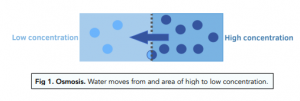Transport in Cells - Osmosis (GCSE Biology)
Osmosis
Osmosis only occurs in the movement of water. It is the net movement of water from an area of high concentration to low concentration. Importantly, it occurs only across a partially permeable membrane. Water can move into and out of cells through the cell membrane.

The concentration of water can also be referred to as water potential. A high concentration of water is a high water potential and a low concentration of water is a low water potential.
Therefore, in osmosis, water moves from a high to a low water potential.
Effect of Osmosis on Cells
Effect on Plant Cells
Water can move into and out of plant cells by osmosis causing different effects:
- Cells become turgid when placed in a solution of a higher water potential. As there is a water concentration difference, water will move from the solution into the cell by osmosis causing the cell to swell and become turgid which supports the cell.
- When plant cells are turgid and full of water, the pressure of the water inside the cell pushing outwards on the cell wall is called turgor pressure. This pressure helps support the cell as
the cell wall is rigid so the water exerts pressure on it. - Cells become flaccid when placed in a solution of a lower water potential. As there is a water concentration difference, water will move from the cell into the solution by osmosis causing the cell to wilt and become limp.
- When the cell membrane detaches and pulls away from the cell wall, this is call plasmolysis. This occurs when the plant is really dehydrated so the cytoplasm inside the cell shrinks and pulls the cell membrane away from the cell wall.
Effect on Animal Cells
- Animal cells do not have a cell wall. This means that they are more heavily affected by changes in concentrations and water potential in the fluid found outside the cell called the tissue fluid.
- Cells can burst when the surrounding fluid has a much higher water potential. Water will move from the surrounding fluid into the cell by osmosis and as the cell only has a cell membrane, the pressure exerted by the excess water can cause the cell to burst.
- Cells can die when the surrounding fluid has a much lower water potential. Water will move from the cell into surrounding fluid by osmosis so the cell will shrivel and die.






Still got a question? Leave a comment
Leave a comment